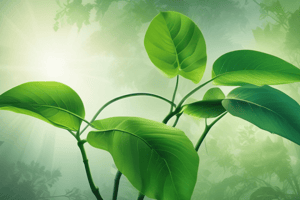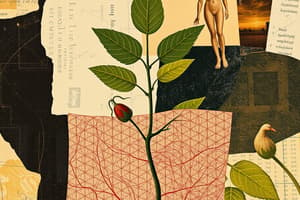Podcast
Questions and Answers
What is the primary function of leaves in a plant?
What is the primary function of leaves in a plant?
- To absorb water and nutrients from the soil
- To carry out photosynthesis (correct)
- To provide structural support to the plant
- To store food and nutrients
What is responsible for transporting water from the soil to the leaves?
What is responsible for transporting water from the soil to the leaves?
- Xylem (correct)
- Phloem
- Root hairs
- Stomata
What is the function of the spongy mesophyll tissue in a leaf?
What is the function of the spongy mesophyll tissue in a leaf?
- To facilitate gas diffusion (correct)
- To produce cuticle
- To absorb light energy
- To store chloroplasts
What is the purpose of the waxy cuticle on the upper epidermis of a leaf?
What is the purpose of the waxy cuticle on the upper epidermis of a leaf?
What is the role of guard cells in a leaf?
What is the role of guard cells in a leaf?
What happens to guard cells when the plant is short of water?
What happens to guard cells when the plant is short of water?
What is the plant equivalent of stem cells?
What is the plant equivalent of stem cells?
What is the purpose of the palisade mesophyll layer in a leaf?
What is the purpose of the palisade mesophyll layer in a leaf?
What is the function of phloem in a plant?
What is the function of phloem in a plant?
What is the primary role of stomata in a leaf?
What is the primary role of stomata in a leaf?
Flashcards are hidden until you start studying
Study Notes
Plant Organization and Leaf Structure
- Plants have different levels of organization, similar to animals, with cells combining to form tissues, tissues combining to form organs, and organs combining to form organ systems.
- A leaf is an organ that, along with stems and roots, forms an organ system responsible for transporting substances around the plant.
Leaf Function and Photosynthesis
- Leaves are the site of photosynthesis, which requires carbon dioxide and water to produce sugars.
- Water is transported from the soil to the leaves by roots and xylem.
- Carbon dioxide diffuses directly into the leaf through small holes called stomata.
Leaf Structure
- A cross-section of a leaf shows different layers, including:
- Lower epidermis (layer of hypodermal tissue)
- Spongy mesophyll tissue (with air gaps between cells for gas diffusion)
- Palisade mesophyll layer (where most photosynthesis occurs, with cells packed with chloroplasts)
- Upper epidermis (another layer of epidermal tissue, almost transparent to allow sunlight to pass through)
Transport of Sugars and Water Loss
- Photosynthesis produces sugar molecules, which are carried to the rest of the plant by phloem.
- Water is continually brought up from the roots to the palisade cells for photosynthesis, but can be lost from the top and bottom of the leaf.
- To reduce water loss, the leaf has a waxy cuticle on top and stomata that are open for as short a time as possible.
Stomata and Guard Cells
- Each stoma is formed from the gap between two guard cells.
- When the plant has plenty of water, guard cells are turgid, allowing more carbon dioxide to diffuse through.
- When the plant is short of water, guard cells become flaccid, closing the stomata and conserving water.
- Guard cells are sensitive to light and close at night when photosynthesis isn't taking place.
Meristem Tissue
- Meristem tissue is the plant equivalent of stem cells, found at the growing tips of roots and shoots.
- Meristem tissue can differentiate into different cell types, allowing the plant to grow.
Plant Organization
- Plants have multiple levels of organization: cells form tissues, tissues form organs, and organs form organ systems.
Leaf Structure and Function
- Leaves are organs that, along with stems and roots, form an organ system responsible for transporting substances around the plant.
- Leaves are the site of photosynthesis, which requires carbon dioxide and water to produce sugars.
- Water is transported from the soil to the leaves by roots and xylem.
- Carbon dioxide diffuses directly into the leaf through small holes called stomata.
Leaf Layers
- A cross-section of a leaf shows different layers, including:
- Lower epidermis (layer of hypodermal tissue)
- Spongy mesophyll tissue (with air gaps between cells for gas diffusion)
- Palisade mesophyll layer (where most photosynthesis occurs, with cells packed with chloroplasts)
- Upper epidermis (another layer of epidermal tissue, almost transparent to allow sunlight to pass through)
Transport of Sugars and Water Loss
- Photosynthesis produces sugar molecules, which are carried to the rest of the plant by phloem.
- Water is continually brought up from the roots to the palisade cells for photosynthesis, but can be lost from the top and bottom of the leaf.
- The leaf has a waxy cuticle on top and stomata that are open for as short a time as possible to reduce water loss.
Stomata and Guard Cells
- Each stoma is formed from the gap between two guard cells.
- When the plant has plenty of water, guard cells are turgid, allowing more carbon dioxide to diffuse through.
- When the plant is short of water, guard cells become flaccid, closing the stomata and conserving water.
- Guard cells are sensitive to light and close at night when photosynthesis isn't taking place.
Meristem Tissue
- Meristem tissue is the plant equivalent of stem cells, found at the growing tips of roots and shoots.
- Meristem tissue can differentiate into different cell types, allowing the plant to grow.
Studying That Suits You
Use AI to generate personalized quizzes and flashcards to suit your learning preferences.





